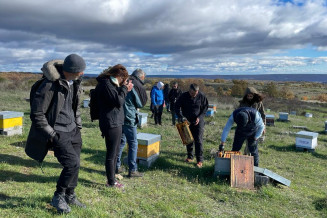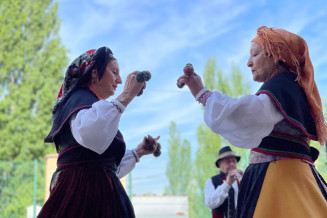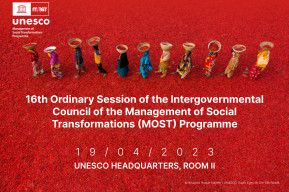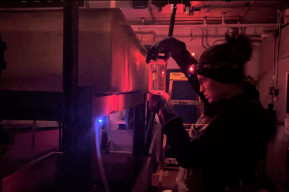From gender roles to local economies, to science and policy, find out how women make a difference in better understanding and protecting mountains. Today we hear from Natalia Castro Nicolás, manager of the Valles Omaña y Luna Biosphere Reserve.
Natalia Castro Nicolás is the manager of the Valles de Omaña y Luna Biosphere Reserve, located in the Cantabrian Mountains in northwestern Spain. Designated in 2005, this 81,000-hectare mountain biosphere reserve has a population of 2,813 (2016) and is surrounded by six other biosphere reserves in the Province of León on the south face of the Cantabrian Mountains. Together, they encompass 273,130 hectares and 29,342 inhabitants (2018) in a model of wide scale landscape management.
As a manager, Natalia Castro Nicolás participated in the conception and launch, in 2021, of the World Network of Mountain Biosphere Reserves of the MAB Programme. The Valles de Omaña y Luna Biosphere Reserve shares the role of technical secretariat of the network with the Research Centre for Eco-Environmental Sciences of the Chinese Academy of Sciences.

You are the manager of the Valles de Omaña y Luna Biosphere Reserve, two adjoining valleys in the Cantabrian Mountains in northwestern Spain. What can you tell us about your biosphere reserve?
The Valles de Omaña y Luna Biosphere Reserve is a fairly large territory, with more than 80,000 hectares, in an area of medium and high mountains. We are home to very high biodiversity, with emblematic species such as the bear, the capercaillie, the wolf, and with large forest masses. We are in an area of contact between the Mediterranean and Eurosiberian climates, which results in this wealth of ecosystems.
We are in a very depopulated area, with an aging population. The population density is less than three inhabitants per square kilometre, but you can see the landscape is the result of the interaction of human communities with the territory that has been inhabited for millennia.
Therefore, we have valleys shaped by extensive livestock farming, with a mosaic of meadows, delimited by dry stone walls and lively woods or “sebes”, and high mountain passes.
As a manager, what is your role?
Managing such a biosphere reserve is a challenge in terms of connecting people. We must be attentive to everything that happens, and act as a link between the stakehdolers, individuals and institutions, who live or work in the territory.
Carrying out this task in a mountainous area impacts everything; the local identity and ways of working are marked by depopulation, accessibility and isolation, long distances, but also by the high biodiversity and living in direct contact with the rhythms set by nature.
The Valles de Omaña y Luna Biosphere Reserve is structured, socially and geographically, around two valleys and their rivers, which run almost parallel to their confluence. These valleys have very different histories that have also conditioned their settlement and their neighbours’ relationship with the place they inhabit.

The biosphere reserve is one of seven in the Province of León, on the south face of the mountain range. What does this teach us about the landscape approach to conservation?
The Cantabrian Mountains are home to a large number of small biosphere reserves. There are seven on the south face alone, and several more on the north face that belong to another administrative province.
We are an almost continuous space, with all the biosphere reserves aligned. When it comes to defining the zoning of these sites and to establishingf conservation strategies, it is important for us to do so in a coordinated way, giving continuity to the core zones with our neighbours. In this way we can speak of a common ecosystemic approach. I think it makes the most sense since all of them share characteristics, protected areas and species.
The common landscape approach also allows us to work together, for example, in tourism: visitors see bears in the Laciana Valley and go hiking and climbing in Omaña and Luna, eat in Alto Bernesga and enjoy the beech forests of Argüellos, visit the pallozas of Ancares and go mountaineering in Babia and Picos de Europa.
The coordination needed to achieve this joint approach is a challenge and involves continuous internal and external communication for the managers, but the result is really rewarding. Right now, we have a group that works in harmony, the institutions responsible for the biosphere reserves are very attached to the territory and the managers work hand in hand with their neighbours, which is a great strength for the Province of León.
Do the communities feel that they are part of this landscape of biosphere reserves?
The identity of the inhabitants of the mountains of León is historical. The peculiarities vary from village to village, but there is a common feeling that we belong to the mountain.
The notion of belonging to a biosphere reserve is starting to grow. A few years ago, we were not well known and our aim was to raise the local community’s awareness. Nowadays the aim is to connect with people. And thanks to the projects that the biosphere reserves are carrying out in a coordinated way, people not only consider themselves to be from Omaña y Luna, but also feel connected with the other neighbouring biosphere reserves. All of this is beginning to give us an entity that I believe will help us to tackle larger projects together.
In terms of connecting with the local community, we have some projects underway to recover knowledge with the elders of the territory. We are approaching all of the villages to recover knowledge about ethnobotany, toponymy or livestock management.
This is rewarding for the people who share valuable information and get recognition, and it also allows us to transmit this knowledge to the generations that follow.

What are you doing with this recovered knowledge?
We are compiling a database with recordings of the interviews and we are preparing publications. But we don't want to stop at just storing this knowledge. We have recently launched another project based on this local knowledge in which we are researching the uses of plants and phytochemical resources for today's bioeconomy.
To address the challenge of attracting new inhabitants to the territory, we must create opportunities for a productive dynamic here, which, in our opinion, must be centred on the bioeconomy. The knowledge from previous generations forms a basis that can help establish new entrepreneurs. Although there are still more people leaving than arriving to settle in the biosphere reserve, we are optimistic and believe that we are in a position to maintain the intergenerational transmission of knowledge that can enable us to generate a new economy.
This year, we celebrate International Mountain Day (11 December) under the theme "Women Move Mountains". What can we learn from mountain communities about the role of women?
Historically, women are the ones who have maintained the mountains. Sixty years ago, the economy and family care rested on the shoulders of women, they were the ones who worked both indoors and outdoors to keep the villages going.
Right now, with this new wave of people coming in, women are actively involved in many initiatives and there is no longer that much of a difference in work or socialisation. Well, there is still a lot to do! But together, we seem to be building a new way of relating to each other, more flexible and respectful of people's needs.
The women of this territory have demonstrated their capacity to innovate, to open up to new approaches and to reinvent new ways of living for themselves and for their families. It seems to me that their potential is an immense wealth and that what they are offering us now in the territory is very powerful.
How do you bring about gender equality in the biosphere reserve?
In Omaña y Luna, gender equality and the visibility of women are cross-cutting themes that permeate all our activities. Right now, all our governing and consultative bodies have equal representation.
In our citizen science processes, in schools, in entrepreneurial forums, in the recovery of traditional knowledge, we want to incorporate the voice of women and give examples to future generations of life goals carried out by men and women. We want to break down the limits that exist between gender roles and the stereotypes of mountain jobs.
Now, in this corner of the mountain, the voice and presence of women is powerful and is showing us a new reality.

Can you tell us an example of how women move mountains?
It's not so much about one woman. If you look for one woman who moves mountains, you will find five or six other women around her, because they quickly build networks between them.
One example of a network that drives a community: there is a woman from a village in Omaña, a hiking trail guide and environmental educator, who a few years ago also started a project to raise and sell organic eggs. She sells them on her farm, but also takes her product to other villages. Two villages down, a young beekeeper has launched her own brand of honey. Three villages further up another woman with an extensive livestock farm started selling meat directly. Now you can find these three women’s products in a new zero-kilometre marketing network, and more and more proposals are joining it.
These are the women and the companies we work with. And when you look at the support and solidarity that binds them, which is what has always allowed the mountain communities to survive, you realise that they give us the possibility of thinking about a future for us all.
For almost a year now, you have been working as joint technical secretariat with the Research Centre for Eco-Environmental Sciences (RCEES) of the Chinese Academy of Sciences on the newly-founded World Network of Mountain Biosphere Reserves. What are the advantages of global cooperation between biosphere reserves?
With the philosophy of the MAB Programme in mind, seeing what is happening in one mountain area so that it can be replicated in others is a huge advantage. We can act as connected research laboratories and transmit and apply knowledge more efficiently.
More than half of the biosphere reserves in the world are mountain biosphere reserves and all these territories are joining the mountain network with the intention of working together and seeking solutions to their common problems. This means having a huge capacity to work and a huge amount of knowledge and experiences distributed all over the world.
It is a bit scary too, but it is a wonderful challenge that allows us to see that the identity of belonging to the mountains exists all over the world.
What are the advantages of working together as technical secretariats in the network?
The coordinated work with our colleagues in China is also an example of what the network wants to achieve. We are two technical secretariats, Omaña y Luna in Spain, which represents territorial and community management, and the RCEES, a research centre in China, which represents academia and scientific research.
One of the objectives of the network is that the knowledge present in mountain biosphere reserves and scientific knowledge go hand in hand. We want to establish a constant and mutual flow between the two. Having two secretariats, one in each field, allows us to exemplify what we want to happen in the network.
It is a complex job because there is a boundary between management and science. But finding points of permeability in that space is a job we think should be done in itself.
And finally, how do you see the future for the network and the priorities in the coming years?
With a lot of work! 2023, I think, will be the year in which we will be able to see joint projects materialise. Interest in the network is growing every day and we are identifying common issues that we need to work on.
The future is very exciting. We are taking on from a lot of great work that has been carried out for years by great teams of professionals and now we have the challenge of connecting, promoting and boosting that work with all the mountain biosphere reserves that are joining the network.
Fantastic projects are being carried out in each territory, so if we can help these good practices to spread and be replicated or carried out jointly, we will be providing an important service to all the mountain areas of the planet.










